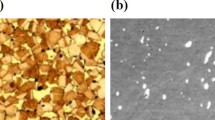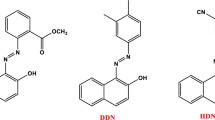Abstract
The corrosion electrochemical behavior of copper-based alloys (L63, cupronickel, Monel, Cu–Al) in high-temperature salt electrolytes of various compositions in the galvanostatic mode is studied. Brass L63 is the most promising copper-based alloy for the production of nanoporous and mesoporous materials in salt melts. L63 brass samples have the smallest average pore diameter in experiments with a chloride melt. The pore size was 1.1 μm in the galvanostatic mode under the specified conditions (200 A/m2, 500°C). The results of cyclic voltammetry can be applied to predict the character of electrochemical destruction and to analyze the stages of conjugated anodic processes. The influence of the nature of the second alloy component on the character of electrochemical destruction and the formation of the developed surface layer of the alloys is found.







Similar content being viewed by others
REFERENCES
Ya. M. Kolotyrkin, “Pitting corrosion of metals,” Zashch. Met. 11 (6), 675–686 (1975).
Ya. M. Kolotyrkin, “Mechanism of the anodic dissolution of homogeneous and heterogeneous metallic materials,” Zashch. Met. 19 (5), 675–685 (1983).
Ya. M. Kolotyrkin, “On the mechanism of the mutual influence of metallic alloy components on the kinetics of their anodic dissolution in solutions of electrolytes,” Elektrokhim. 28 (6), 939–943 (1992).
O. D. Trong, D. Desplantier-Giscard, C. Danumah, and S. Kaliaguine, “Perspectives in catalytic applications of mesostructural materials,” Appl. Cat. A: Gen. 253, 545–602 (2003).
B. C. Tappan, S. A. Steiner, III, and E. P. Luther, “Nanoporous metal foams,” Angew. Chem. 49, 4544–4565 (2010).
Jintao Zhang and Chang Ming Li, “Nanoporous metal: fabrication strategies and advanced electrochemical applications in catalysis, sensing and energy system,” Chem. Soc. Rev. 41, 7016–7031 (2012).
Q. Zhang and Z. Zhang, “On the electrochemical dealloying of Al-based alloys in a NaCl aqueous solution,” J. Phys. Chem. Chem. Phys. 12 1453–1472 (2010).
M. Nakamada and M. Mabuchi, “Preparation of nanoporous Ni and Ni–Cu by dealloying of rolled Ni–Mn and Ni–Cu–Mn alloys,” J. Alloys Compd. 485 (1–2), 583–585 (2009).
Y. Wang, J. Xu, and B. Wu, “Electrochemical dealloying of Al2(Au, X) (X = Pt, Pd, PtPd, Ni, Co and NiCo) alloys in NaCl aqueous solution,” J. Phys. Chem. Chem. Phys. 15, 5499–5509 (2013).
E. B. Khobotova and L. M. Egorova, “Regularities of the electrochemical dissolution of the L-62 alloy in chloride solutions,” Elektr. Obrab. Met. 50 (1), 39–44 (2014).
Ch. F. Zung, N. M. Tutukina, and I. K. Marshakov, “Tendency of brasses to dezincing in chloride media,” Kondens. Sredy Mezhfaz. Gran. 11 (4), 349–353 (2009).
O. A. Bannykh, P. B. Budberg, S. P. Alisova, et al., State Diagrams of Binary and Multicomponent Iron-Based Systems (Metallurgiya, Moscow, 1986).
P. Du, J. Li, Y. Zhao, Y. Dai, Zh. Yang, ad Y. Tian, “Corrosion characteristics of Al alloy/galvanized-steel couple in NaCl solution,” Int. J. Electrochem. Sci. 13, 11164–11179 (2018).
H. W. Pickering and C. J. Wagner, “Electrolytic dissolution of binary alloys containing a noble,” J. Electrochem. Soc. 114 (7), 698–706 (1967).
Yu. Ya. Andreev, “Description of diffusion in a binary alloy during its mass transfer with the external environment,” Dokl. Akad. Nauk SSSR 278 (5), 1153–1155 (1984).
M. V. Smirnov, Electrode Potentials in Molten Chlorides (Nauka, Moscow, 1973).
Funding
This work was supported by the Russian Foundation for Basic Research, project no. 17-03-00715 A.
Author information
Authors and Affiliations
Corresponding author
Additional information
Translated by E. Yablonskaya
Rights and permissions
About this article
Cite this article
Karfidov, E.A., Nikitina, E.V., Kazakovtseva, N.A. et al. Character of Selective Anodic Dissolution. Influence of the Alloy Composition. Russ. Metall. 2020, 127–132 (2020). https://doi.org/10.1134/S003602952002007X
Received:
Revised:
Accepted:
Published:
Issue Date:
DOI: https://doi.org/10.1134/S003602952002007X




